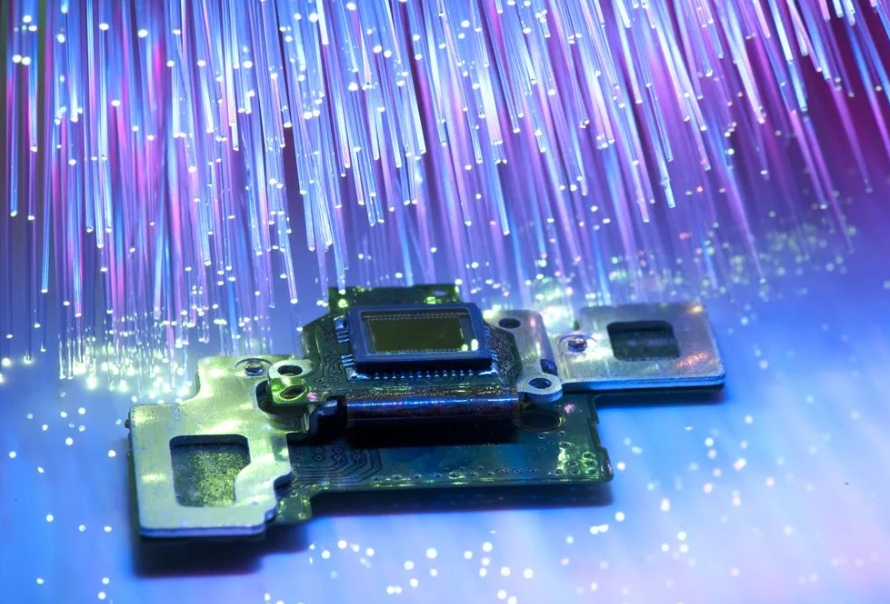With the rapid development of artificial intelligence, 5G, quantum computing and data communication technologies, silicon photonics and photonic integrated circuits have gradually become indispensable key technologies for modern technology.
Advantages of silicon photonics and PICs
One of the biggest advantages of silicon photonics and photonic integrated circuits is the ability to fabricate using existing CMOS technologies, i.e., traditional semiconductor manufacturing processes, pushing processing power to higher limits. This allows them to surpass traditional electronic chips in terms of data transfer rate, power consumption, and size, making them an ideal solution for high-bandwidth applications. For example, silicon photonics and PICs are capable of delivering speeds of 1.6 Tbps per second or more in a single device, which is difficult to achieve with traditional electronic circuits.
In addition, silicon photonics enables highly integrated photonic components by using materials such as silicon or silicon dioxide. Compared with traditional electronic circuits, photonic integrated circuits have stronger anti-interference capabilities, higher bandwidth, and lower latency, making them show great potential in applications such as data centers, ultra-high-performance computing (HPC), quantum computing, and AI accelerators.
Challenges in continuous innovation
Although silicon photonics and photonic integrated circuit technology have shown great potential in many fields, there are also some challenges that cannot be ignored. First, since silicon, as an indirect bandgap semiconductor, is not an efficient light source or photodetector on its own, it is often required to be used in combination with III-V materials such as indium phosphorus InP for light source and light detection functions. The complexity of this technology makes integration difficult.
Secondly, despite the small size and high integration of photonic integrated circuits, the selection of materials, the stability of devices, and the maturity of processes still need to be further solved in the actual manufacturing process. Especially in terms of cost control, the initial R&D and production costs are high, especially before mass production, and large-scale market demand may be required to compensate for these costs.
Silicon photonics and the future of materials for PICs
With the deepening of research, the material selection of silicon photonics and photonic integrated circuits is constantly expanding. At present, silicon and silica are still the most commonly used photonic integration materials, but they are often used in combination with group III-V materials because silicon itself is not suitable for efficient light sources and photodetectors. In addition, some new materials are emerging that could change the material landscape of future PICs.

Figure: Market and technology forecast for photonic integrated circuits in the next decade
1. Thin-film lithium niobate (TFLN): As an emerging material, thin-film lithium niobate has become a strong competitor for quantum computing and high-performance modulation applications due to its low material loss and moderate Pockels effect. Its low loss makes it advantageous in high-speed photonic communication.
2. Indium phosphorus (InP): As an efficient light detection and light emission material, indium phosphorus still occupies an important position in photonic integrated circuits. Many high-performance photonic transceivers rely on the excellent performance of indium phosphorus.
3. Exploration of new materials: Materials such as barium titanate (BTO) and rare earth metals are being studied for quantum computing and other cutting-edge applications, and are expected to show great potential in special fields in the future.
AI-driven demand has surged
The rapid development of AI technology has brought unprecedented market opportunities for silicon photonics and photonic integrated circuits. AI accelerators, such as NVIDIA's GPUs, require high-bandwidth and high-speed data transmission to support their massive data processing needs. Because of this, silicon photonics and photonic integrated circuits have become key technical supports.
In the case of NVIDIA's latest Blackwell CPUs, they require two 800G photonic transceivers per GPU, driving the need for higher-speed photonic transceivers. According to IDTechEx, 3.2Tbps photonic transceivers will be available in the market in 2026 to meet the urgent need for high-speed data communication in AI accelerators.
The application prospect is broad
Applications for silicon photonics and photonic integrated circuits are rapidly expanding, with future applications ranging from chip-to-chip high-bandwidth interconnects, advanced packaging and co-packaged optics to sensors and quantum computing.
1. Photonic Engines and Accelerators: High-performance photonic accelerators can be designed and manufactured using components in photonic integrated circuits, such as Mach-Zehnder interferometers, to break through the performance bottleneck of electron accelerators. This technology could provide more computing power for areas such as AI and quantum computing.
2. PIC-based sensors: For example, Silicon Nitride materials can be used to make gas sensors and "artificial noses", which will be widely used in healthcare, environmental monitoring, and wearable devices.
3. PIC-based FMCW LiDAR: This technology is expected to be widely used in autonomous vehicles, agricultural drones, and other fields to promote automation and intelligence.
4. Quantum computing: With the continuous advancement of quantum computing technology, the applications of silicon photonics and photonic integrated circuits are also expanding. Many quantum computing companies are investing in PICs to enable more stable and scalable quantum systems.
Market outlook and forecasts
According to IDTechEx, the PIC market will grow by 2.4x over the next decade, driven by the surge in demand for high-performance photonic transceivers in the AI and 5G markets. With the continuous development of technology, silicon photonics and photonic integrated circuits will become indispensable core technologies in many fields such as data communication, AI acceleration, and quantum computing.





